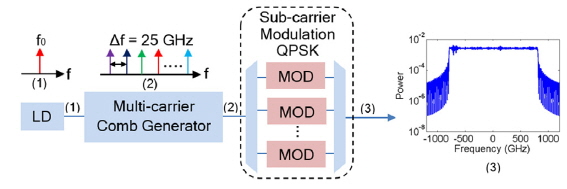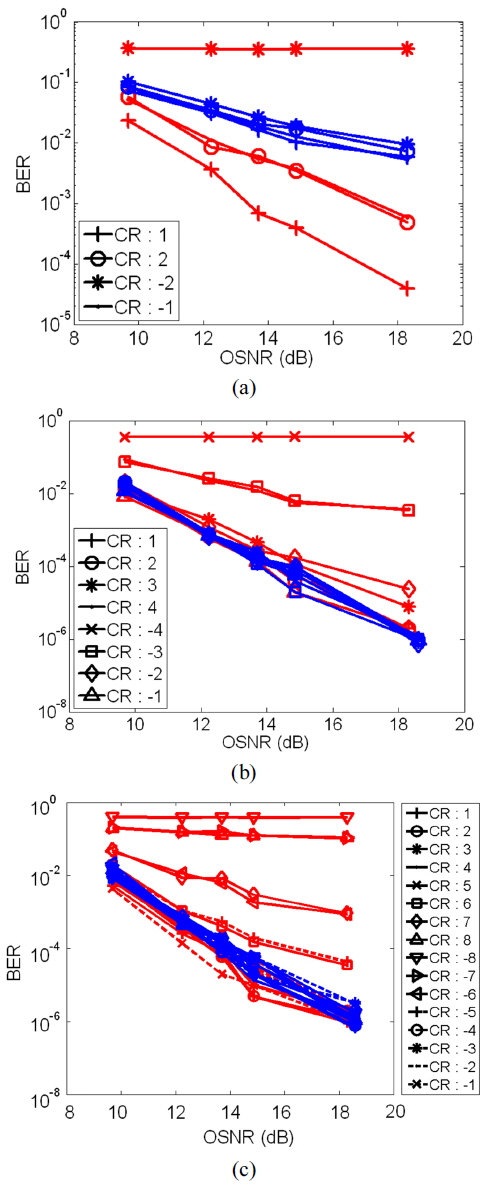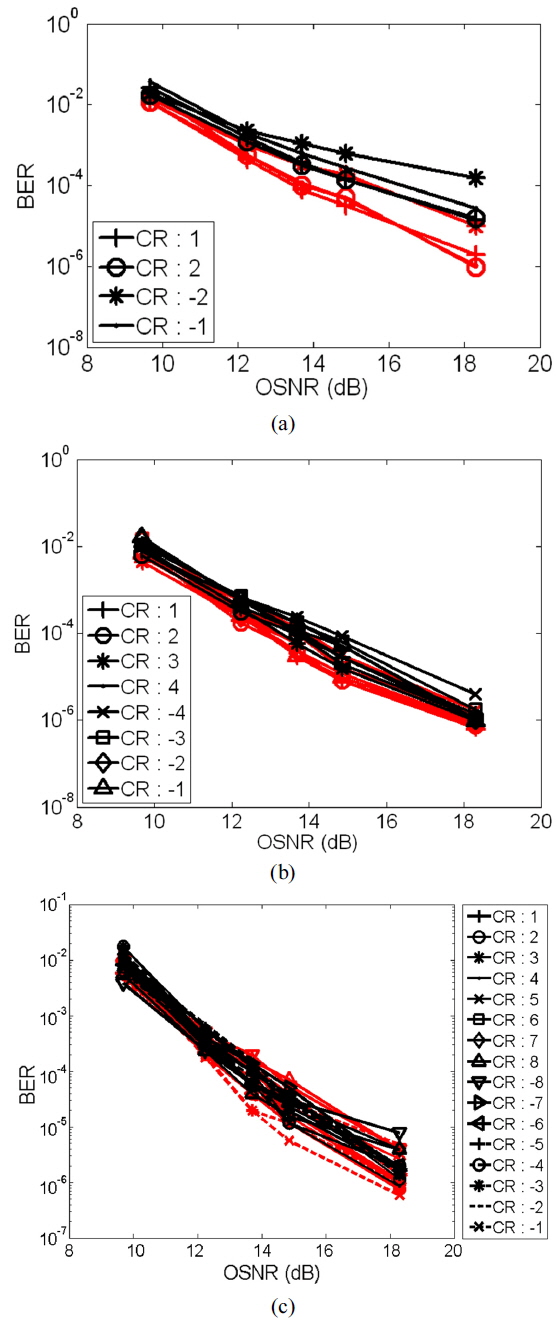



To meet the forecasted growth rate of internet traffic, on the order of Tb/s, enhancing the capacity of a singlecarrier transmission system is critically challenging, due to the large penalty from fiber impairments and also a lack of high-speed commercial electronics, which are most likely to remain unavailable in the foreseeable future. Even though the capacity of a transmission system can be increased by incorporating higher-order modulations, such as PM-16QAM or PM-64QAM [1], it becomes more susceptible to noise, and its reach also decreases as the modulation order increases. In this regard, optical super-channel technology can be viewed as a strong candidate to satisfy tangible Tb/s transmission, where coherently generated, dense multiple carriers are demultiplexed and decoded by orthogonal frequency multiplexing (OFDM) [2], or by Nyquist wavelength division multiplexing [3]. In a super-channel transmission system, the required capacity is usually attained by combining a large number of optical carriers, where each carrier maintains a certain phase relation to the others and is modulated at a lower bit rate, so as to be terminated at a receiver for a service interface [4]. The first successful long-haul super-channel transmission of 1.15 Tb/s over a distance of 10,000 km was reported in [5], while a record-breaking 26 Tb/s super-channel transmission experiment was reported in [2]. In this paper, the super-channel is formed using OFDM technology because of its potentially high spectral efficiency, fine-granularity, and high tolerance of transmission impairments like optical nonlinearity [6], chromatic dispersion [7], and polarization mode dispersion [8].
One of the crucial requirements for successfully deploying optical super-channel technology is the flexibility in carrier assignments, where an arbitrary number of multiple adjacent carriers are grouped to form subbands that can be demultiplexed and demodulated independently from other subbands. This enables the super-channel to provide flexible services of various requirements elastically, to handle differing capacity, modulation format, spectral efficiency, number of carriers, bandwidth, etc., for each subband. A typical super-channel receiver can demultiplex and demodulate a small number of carriers in a group (
II. PRINCIPLE OF PARTIAL DEMULTIPLEXING IN AN OFDM SUPER-CHANNEL TRANSMISSION SYSTEM
In an OFDM super-channel environment, the spectrum can be extremely wide, since hundreds of OFDM carriers are multiplexed over a single wavelength. In this work, we focus on how to demultiplex a portion of the entire OFDM spectrum. For a better understanding, we intuitively divide the entire spectrum into multiple OFDM subbands and decode each subband with partial demultiplexing, as shown in Fig. 1. There are no restrictions on the number of subbands in the spectrum, nor on the number of carriers in each subband. Due to the orthogonality property of the OFDM [10], the carriers in each subband can have a spacing of Δ
In this paper, by considering all-optical and electronic DFT technologies, we investigate two OFDM super-channel receiver models for partial carrier demultiplexing with minimum power and bandwidth consumptions.
III. SUPER-CHANNEL SYSTEM MODEL
In this section, we discuss our system model for the Tb/s optical OFDM super-channel transmission system, which includes transmitter and receiver designs. We first describe the transmitter setup, and then the receiver setup for partial carrier demultiplexing.
3.1. OFDM Super-channel Transmitter Model
In the transmitter, a set of frequency-locked carriers is assumed to be generated from a mode-locked laser (MLL) synchronized at its fundamental frequency [11], a comb generator employing a concatenated, overdriven optical phase modulator [2], or a recirculating frequency shifter, as shown in Fig. 2. Similar to a DWDM approach, we deploy an arrayed waveguide grating (AWG) device to split the frequency comb into its nonoverlapping Fourier components with a channel spacing of Δ
In this work, a total number
3.2. OFDM Super-channel Receiver Model
In this subsection, we present two optical super-channel receiver models as partial carrier demultiplxers. These can be termed as (1) an electronic FFT-based CO-OFDM, and (2) an all-optical demultiplexing and coherent demodulation OFDM super-channel receiver.
3.2.1. Electronic FFT-based CO-OFDM Super-channel Receiver
A schematic diagram of the coherent optical-OFDM (CO-OFDM) super-channel receiver is illustrated in Fig. 3. In this design, the FFT is performed electronically. The major components of the receiver include: (1) a homodyne coherent receiver; (2) two ADCs; (3) an electronic FFT circuit; and (4) a phase estimator, to eliminate the phase noise generated from an LO. Although the architecture of the homodyne receiver is quite complex, it is a preferred technology, because of its minimal electrical-bandwidth requirement and 3-dB higher sensitivity, compared to heterodyne detection [12].
In the first place, the transmitted coherent modulated optical signals are extracted, using a second-order super-Gaussian filter with a bandwidth marginally larger than
3.2.2. All-optical Demultiplexing and Coherent Demodulation OFDM Super-channel Receiver
The AO-DFT-based all-optical demultiplexing and coherent demodulation OFDM super-channel receiver is illustrated in Fig. 4(a). The major components of the receiver are (1) an AO-DFT circuit for partial carrier demultiplexing, and (2) a coherent receiver for optical-to-electrical (O/E) conversion and symbol demodulation in each demultiplexed carrier. Therefore, we first introduce the AO-DFT process, and then the overall operation of the receiver is discussed.
The AO-DFT circuit is a simple device that can perform both serial-to-parallel conversion and DFT processing all-optically. In this paper, the DFT is realized by tuning the phase of Mach-Zehnder delay-and-add interferometers (MZDI), couplers, and optical gates. With this device the DFT can be performed on a continuous signal, so no ADCs are required. In addition, the circuit consumes little or no power, as it consists of passive optical components. An exemplary illustration of an 8-point AO-DFT circuit can be found in Fig. 4(b). For an 8-point AO-DFT, we cascade 3 MZDIs for each carrier, with delay and phase adjustments in the upper and lower arms respectively. At the end of the AO-DFT circuit, an optical gate, such as an electro-absorption modulator (EAM), is placed at each output arm of the last cascading stage, to sample at the center of a symbol period. The transfer function of cascaded couplers with a delay line in the lower arm of a MZDI is expressed in Eq. (1) [11].
In Eq. (1),
In this receiver design, the transmitted signals modulated by QPSK are demultiplexed first using a MZDI-based
In this section, we investigate the performance of the super-channel receivers in elastic demultiplexing at a transmission rate of 64 × 50 Gb/s over an amplified fiber, with an amplified spontaneous emission (ASE) noise model. The simulated transmitter model follows the design presented in Section 3.1. Because of the carrier spacing of 25 GHz, the symbol duration is assumed to be
Figure 5 compares the BER performances of the aforementioned receiver designs as a function of OSNR for a back-to-back transmission situation. The data in the figure correspond to the BER results in demultiplexing of subbands with
Figure 5(a) shows BER versus OSNR data for
Figures 5(b) and 5(c) present similar data plots for
One possible way to mitigate the effect of aliasing on the electronic FFT-based CO-OFDM super-channel receiver is oversampling. In this paper, two oversampling scenarios are considered: Case 1, 50% oversampling, and Case 2, 100% oversampling. In Case 1, 50% oversampling is achieved by sampling a signal with
Several important conclusions can be drawn from the above simulation results: (1) With AO-DFT, all carriers can realize nearly equal gain in performance and no carriers suffer from aliasing, because the optical waveform of the symbol is demultiplexed before being sampled. (2) A 4-point MZDI-based AO-DFT circuit failed in demultiplexing, and at least three cascaded 8-point MZDIs or
In this paper, we model a 64 × 50 Gb/s optical OFDM super-channel transmission system with 64 carriers, and demultiplex the super-channel carriers flexibly in the form of a subband, using two distinct receiver designs. The receivers for partial-carrier demultiplexing employ electronic and all-optical DFT technologies respectively to form (i) an electronic FFT-based super-channel receiver, and (ii) an AO-DFT-based super-channel receiver. The BER-performance results reveal that the electronic FFT-based super-channel receiver suffers from aliasing, which can be mitigated by oversampling. The simulation results also reveal some minor limitations of MZDI-based AO-DFT implementation that require more than the first few MZDI cascading stages. Nonetheless, the AO-DFT-based super-channel receiver consumes no or little power. It neither suffers from aliasing nor requires any ADC/DAC. Therefore the significance of an AO-DFT-based partial carrier demultiplexer in optical super-channel technology could be immense.




![(a) Receiver setup for the AO-DFT-based coherent modulated OFDM super-channel receiver. LO: local oscillator, PD: photodiode, LPF: low pass filter, A/D: analog-to-digital. (b) Schematic illustration of an eight-carrier optical-DFT example [11].](http://oak.go.kr/repository/journal/15909/E1OSAB_2015_v19n4_334_f004.jpg)


